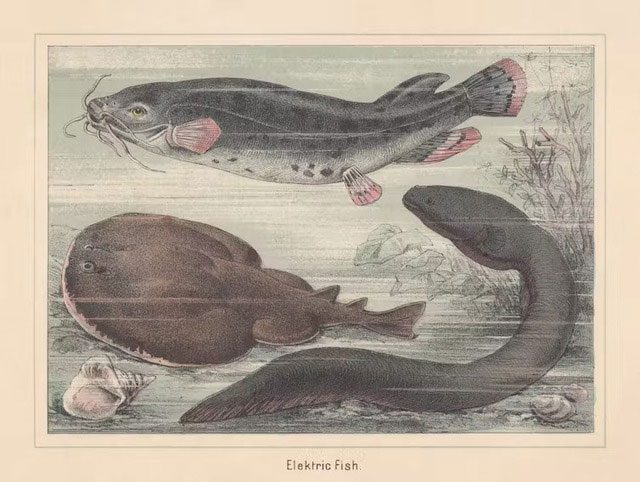Batteries are considered a great invention, used in countless technological devices today, including smartphones. However, few people know that without inspiration from this seemingly terrifying creature, there would be no smartphones with enough battery to last us all day.
Volta’s Battery
As the demand for mobile energy skyrockets worldwide, many inventors have sought to replace current battery technology with something better.
Italian physicist Alessandro Volta harnessed basic electrochemical principles when he invented the first battery in 1800. In simple terms, the physical combination of two different materials, usually metals, creates a chemical reaction that leads to a flow of electrons from one material to the other. This electron flow represents mobile energy that can be harnessed to generate electric power.
The first materials used to produce batteries were copper and zinc. Today’s best batteries—producing the highest power output in the smallest possible size—combine lithium with various other metal compounds.
Stable improvements have occurred over centuries, but modern batteries still rely on Volta’s similar principle: combining materials that can create electrochemical reactions and extracting the generated electrons.
However, before artificial batteries began generating electricity, electric fish, such as the Mediterranean electric ray and particularly the freshwater electric eels of South America, have been renowned for their incredible power generation capabilities.
In fact, electric fish inspired Volta to conduct the initial research that ultimately led to the creation of the battery, and today’s battery scientists still look to these electric animals for ideas.

Freshwater electric eels in South America are famous for their incredible power generation capabilities. (Illustrative image).
Inspiration from Electric Eels
Before Volta’s battery was invented, the only way for humans to generate electricity was to rub different materials together, typically silk on glass to generate static electricity. This was not an easy or practical way to create useful electrical energy.
Volta understood that electric fish have a specialized organ for generating electricity. He reasoned that mimicking this operational principle could lead to a new way of producing electricity.
The electric organ of the fish comprises stacks of cells resembling rolls of coins. Thus, Volta cut disc-like slices from separate materials and started stacking them in different sequences to see which combination could generate electricity.
These stacking experiments yielded no results until he tried combining copper discs with zinc discs while separating stacked pairs with paper discs moistened with saltwater.
This copper-zinc paper chain randomly generated electricity, with the electric output corresponding to the height of the paper stack. Volta believed he had discovered the secret of how eels generate electricity and created an artificial electricity-generating version of them, initially calling his discovery “artificial electric organ.” However, this nomenclature was fundamentally incorrect.

Eels utilize a similar approach to how our nerve cells produce electrical signals. (Illustrative image).
What Truly Powers Electric Eels?
Scientists today understand that the electrochemical reaction between the different materials Volta discovered has nothing to do with how electric eels generate electricity. Rather, the eel employs a mechanism similar to how our nerve cells produce electrical signals, but on a much larger scale.
Specialized cells in the eel’s electric organ pump ions across a semi-permeable membrane barrier to create a charge difference between the inside and outside of the membrane.
When the micro-gates in the membrane open, the rapid movement of ions from one side to the other creates an electric current. The eel can simultaneously open all its membrane gates at will to generate a massive electric flow, releasing it deliberately onto its prey.
Electric eels do not shock their prey to death; they merely stun the target with electricity before attacking. An eel can produce a current of hundreds of volts, but the voltage does not push enough current for a long enough period to kill the prey. Each electric pulse from the eel lasts only a few milliseconds and delivers less than 1 amp, which is equivalent to 5% of household current.
This is similar to how electric fences operate, providing very short high-voltage pulses but with very low current intensity. Thus, they are sufficient to shock but not kill bears or other intruding animals attempting to climb over.
It is also akin to modern stun weapons, which operate by delivering a high-voltage pulse (about 50,000 volts) with very low current intensity (only a few milliamps).

Volta at his laboratory experiment.
Efforts to Mimic Eels
Like Volta, some modern electrical scientists are seeking to transform battery technology inspired by electric eels.
A team of scientists from the US and Switzerland is currently researching a new type of battery inspired by the eel.
They envision that this soft and flexible battery could someday be useful for powering internal components in medical implants and soft robotics. However, the team acknowledges that there is a long way to go.
“The electric organs in eels are incredibly sophisticated; they generate energy much better than we do,” lamented Michael Mayer, a team member from the University of Fribourg. Thus, research into eels continues.
In 2019, the Nobel Prize in Chemistry was awarded to three scientists who developed lithium-ion batteries. In awarding the prize, the Royal Swedish Academy of Sciences stated that the work of the laureates had “laid the foundation for a wireless, fossil fuel-free society.”
The “wireless” part is accurate, as lithium-ion batteries currently power nearly all handheld wireless devices, and smartphones are among them.
Later that year, scientists from the Smithsonian Institution announced the discovery of a new species of electric eel in South America; notably, this is the most powerful known biological generator on Earth.
Researchers recorded the discharge of one eel at 860 volts, significantly higher than the previous record-holding eel species at only 650 volts.
As humans take pride in creating the latest mobile energy sources, electric eels continue to outpace us with their abundant energy supply.


















































